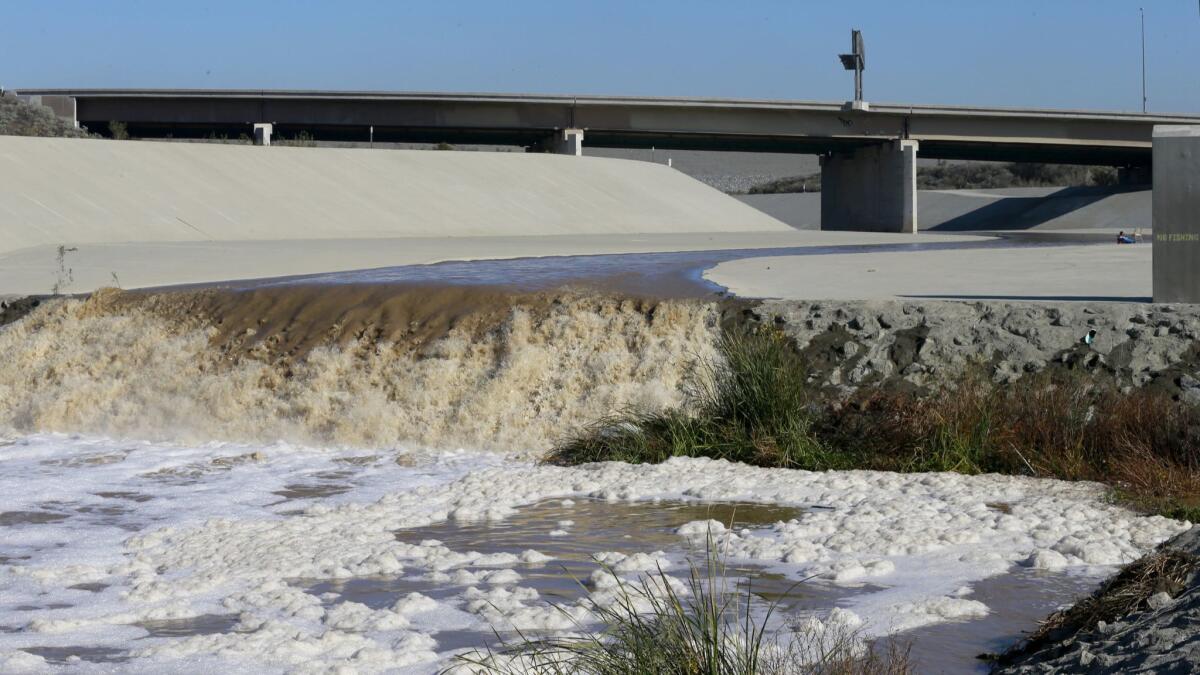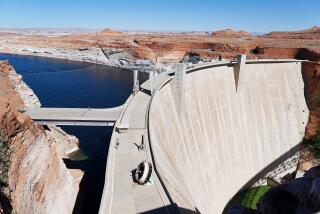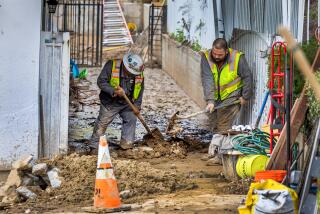Engineers up failure risk for dam protecting Disneyland, dozens of Orange County cities

Federal engineers are raising alarms that a “significant flood event” could compromise the spillway of Southern California’s aging Prado Dam and potentially inundate dozens of Orange County communities from Disneyland to Newport Beach.
After conducting an assessment of the 78-year-old structure earlier this month, the U.S. Army Corps of Engineers announced that it was raising the dam’s risk category from “moderate” to “high urgency.”
“Our concern right now is about the concrete slab of the spillway and how well it will perform if water were to spill over the top of the dam,” said Lillian Doherty, the Army Corps’ division chief. “We will determine whether or not it is as reliable as it should be.”
Located beside the 91 Freeway on the border of Riverside and Orange counties, the dam impounds little to no water for much of the year. During periods of heavy rain, however, the structure is intended to collect water and prevent flooding along the Santa Ana River.
Doherty said her agency is working with a national team of experts to develop interim and permanent risk-reduction measures at the dam, as well as public outreach strategies to alert the estimated 1.4 million people who live and work in 29 communities downstream.
The sudden downgrade in the structure’s evaluation comes after major problems have been identified in California dams.
RELATED: Rare L.A. mega-storm could overwhelm dam and flood dozens of cities, experts say
In February 2017, a concrete spillway at the Oroville Dam disintegrated during heavy rains and triggered the evacuation of more than 180,000 people. The head of the California Water Resources Department, which operates the dam, was removed after an independent probe found the failure was the result of a lax safety culture.
That same year, the Corps of Engineers discovered that the 60-year-old Whittier Narrows Dam, about 40 miles to the west of Prado Dam, was structurally unsafe and posed a potentially catastrophic risk to more than 1 million people in working-class communities along the San Gabriel River floodplain.
In that case, engineers found that intense storms could trigger a premature opening of that dam’s massive spillway, swamping homes, schools, factories and roads from Pico Rivera to Long Beach. Engineers also found that the earthen structure could fail if water were to flow over its crest.
The Corps estimates it will cost roughly $600 million in federal funds to upgrade the Whittier Narrows facility, which has been reclassified as the agency’s highest priority nationally because of the risk of “very significant loss of life and economic impacts.”
Now, given concerns that Prado Dam poses a flood threat to much of Orange County, the agency is collaborating with Los Angeles, Orange and Riverside counties and several dozen municipalities to develop emergency plans that could be implemented before repairs to the dams are completed.
Col. Aaron Barta said the retrofit operations on the spillways at both dams could begin as early as 2021.
An $880-million effort to increase storage capacity for floodwaters and sediment at Prado Dam has been underway since 2002. It includes raising the spillway crest by 20 feet to an elevation of 563 feet, replacing outlet systems, increasing the reservoir area, building new dikes and improving the wetlands behind the dam and the downstream channel for flood control purposes, as well as for habitat and possible recreational opportunities.
Despite a development boom in neighboring Chino, Corona, Norco and Eastvale, the 2,150 acres of wetlands behind the dam comprise a labyrinth of channels, ponds and forests that are havens for threatened and federally endangered species including red-sided garter snakes and least Bell’s vireos.
In the meantime, the Prado and Whittier Narrows dams continue to be fully functional and operable during storm events, said Dena O’Dell, a spokeswoman for the agency.

A bill awaiting Gov. Jerry Brown’s signature would establish a Santa Ana River Conservancy Program, which would be administered by the state Coastal Conservancy.
“Corps staff is routinely on site at Prado Dam to operate and monitor the dam during rain events,” she said. “The Corps’ assessment of the dam doesn’t mean that failure is taking place; it means the agency has identified performance concerns that require attention to meet the corps’ rigorous dam safety standards.”
But some researchers doubt the overall safety of aging federal flood control systems that were not designed with climate change in mind.
They argue that in a warming world, regions such as California will experience more whiplashing shifts between extremely dry and wet periods. These cycles, they say, will seriously challenge California’s ability to control flooding, as well as store and transport water.
“A troubling theme is emerging as the Corps reviews its portfolio of large flood control systems that were built a long time ago and are now showing signs of severe stress,” said Daniel Swain, a UCLA climate scientist. “Federal engineers are finding that these systems are not as resilient as they thought they were, and that the frequency of what were regarded as once-in-a-lifetime storms is increasing significantly.”
Doherty would not go that far.
“Unpredictable things can happen,” Doherty said. “But we are the preeminent flood risk management and engineering agency in the United States — we are all about keeping people safe.”
More to Read
Sign up for Essential California
The most important California stories and recommendations in your inbox every morning.
You may occasionally receive promotional content from the Los Angeles Times.











